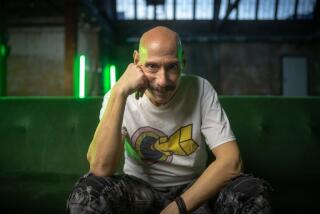Disco’s Comeback More Than Nostalgia
- Share via
What a difference a couple of decades make.
On July 12, 1979, a Chicago disc jockey named Steve Dahl took the field before a double-header at Comiskey Park to show the world just how much rock fans hated disco. After ranting a bit about how disco represented everything evil and anti-rock in the world, he piled a couple hundred disco records on the field and burned them, as the fans chanted lustily.
Barely four years after K.C. & the Sunshine Band’s “Get Down Tonight” had topped the charts, disco was officially the enemy. In 1979, “The Bee Gees’ Greatest Hits” topped the chart; in 1980, the group’s “Living Eyes” album couldn’t even crack the Top 40. Disco balls, the glittery, glass-covered orbs found in dance clubs everywhere, were objects of derision. Even Studio 54, once the disco-dancing home of New York’s glitterati, had lost its allure.
Now, 19 years later, all that seems forgotten. Studio 54 is the subject of a movie and several books. Disco compilation albums have become a big business, muscling aside soul and ‘60s rock collections in the CD stores. Even the disco ball is back, turning up in the lighting rigs of concert acts ranging from U2 to Tori Amos.
Some of this, of course, is pure nostalgia. “The mainstream media started to catch onto disco early in its renewed love affair with all things ‘70s,” observes Billboard dance music editor Larry Flick.
Flick cites the early-’90s use of classic disco tracks as runway music in fashion shows as a key factor in disco’s rehabilitation. “Once you could flip on a fashion report on CNN or E! or MTV and hear all those old disco songs, it was just a matter of time before the compilations started to roll out,” he says.
Still, there has to be more to it than mere nostalgia. Nobody is going to look back fondly at music they hated, after all. So the question is, did all those disco-bashers simply forget how much they hated the stuff?
“It seems to me that [disco-hating] went by the boards because rock bands themselves realized it was ridiculous,” says Robert Christgau, a longtime rock critic and senior editor at the Village Voice.
In fact, rock musicians hadn’t run screaming from disco in the first place. Back in the ‘70s, rockers ranging from Rod Stewart (“Da Ya Think I’m Sexy?”) to the Rolling Stones (“Miss You”) to Blondie (“Heart of Glass”) cut singles designed to cash in on the disco craze. Even Johnny Rotten, in his autobiography, admitted that the Sex Pistols had a soft spot for disco.
As time went on, rock’s debt to disco grew. Britain’s Gang of Four, one of the most socially outspoken acts of the early ‘80s, powered its social commentary with disco beats on songs like “To Hell With Poverty” and “I Love a Man in a Uniform”; members of Duran Duran openly admitted to having modeled their sound in part on the ‘70s disco band Chic. Then there was New Order, which became one of the biggest alternative acts of the mid-’80s even though hits “Blue Monday” and “Bizarre Love Triangle” had more in common with Donna Summer’s “I Feel Love” than anything the Sex Pistols recorded.
These days, disco influences in rock are much more overt. U2 introduced its last album, the heavily electronic “Pop,” with a single called “Disco,” while the alternarock band Cake cut an utterly un-ironic cover of the Gloria Gaynor disco hit “I Will Survive.” Even the heavy rock quintet Korn seems to have been infected, as its current single, “Got the Life,” is driven by a hi-hat-spiked disco pulse.
“There is a weird time-lag thing where rock rediscovers stuff,” says Simon Reynolds, author of “Generation Ecstasy: Into the World of Techno and Rave Culture.” He suggests that part of this disco influence stems from the fact that the music is now outdated enough to be seen as ripe-for-the-picking by rock musicians.
“For instance, in the ‘70s rock bands were dealing with the blues and rhythm and blues, which was no longer popular with the black audience at all,” he says. “And then in the ‘80s, especially in Britain, a lot of former punk bands discovered Philly and Curtis Mayfield. So maybe there’s that element.”
Of course, pop singers cozied to disco long before rockers did. Madonna, for instance, started off as a backup singer for French disco star Patrick Hernandez (“Born to Be Alive”), and never really strayed far from the genre, as hits like “Get Into the Groove,” “Express Yourself” and “Deeper and Deeper” owed a lot to the disco sound.
“Pop females have kept dipping into that well, and selling singles on the strength of remixes that were heavily influenced by the Salsoul Orchestra, Philly Soul and the San Francisco Hi-NRG sound,” says Flick, who cites Mariah Carey and Gloria Estefan as fellow discophiles. “Mariah Carey has traditionally gone in and recut her singles into dance songs with heavy disco influences.”
Still, as far as Flick is concerned, the most significant aspect of disco’s return isn’t the music’s sound, but its spirit. Disco as a lifestyle was about indulgence and abandon, and frankly, he says, Americans feel as if they could use a bit of hedonism right now.
“People are just tired of being told they can’t have sex, they can’t get drunk, they can’t do drugs,” he says. “They’re tired of hearing how miserable the world is.
“In my opinion, the reason why [the disco revival] is lasting is because there still is AIDS, and politics are even messier now,” he adds. “I think people are just running away. They’re sick of the hassles.”
More to Read
The biggest entertainment stories
Get our big stories about Hollywood, film, television, music, arts, culture and more right in your inbox as soon as they publish.
You may occasionally receive promotional content from the Los Angeles Times.










